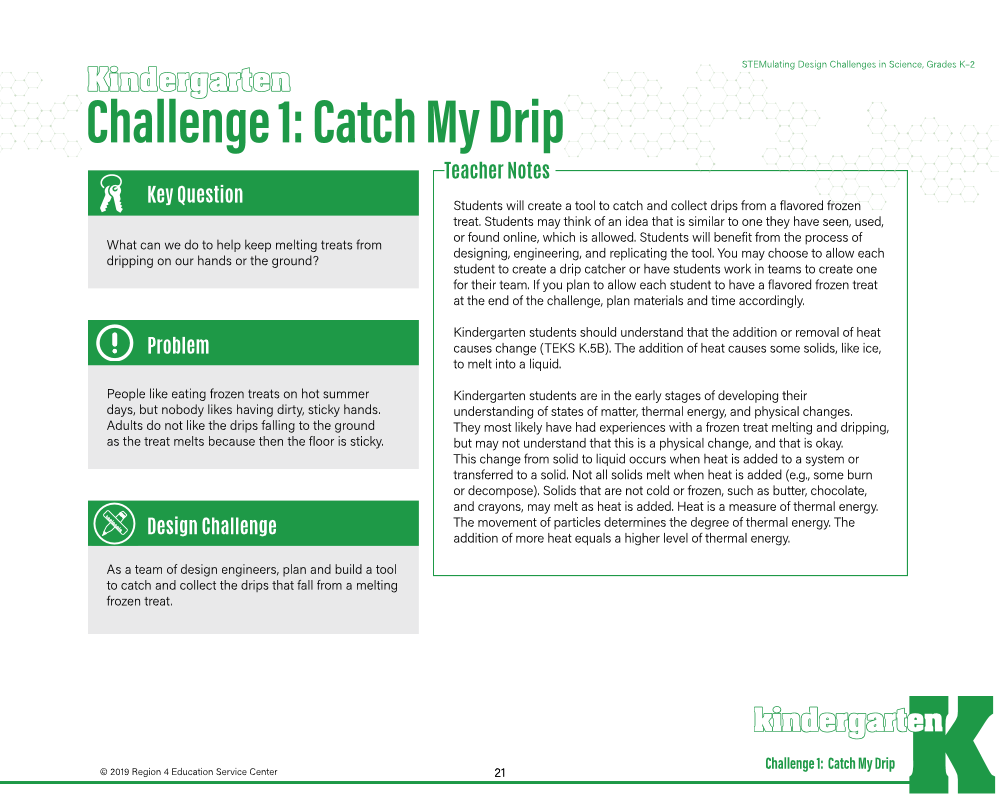21 21
Challenge 1: Catch My Drip
Kindergarten Kindergarten
Teacher Notes
Key Question
What can we do to help keep melting treats from
dripping on our hands or the ground?
Students will create a tool to catch and collect drips from a flavored frozen
treat. Students may think of an idea that is similar to one they have seen, used,
or found online, which is allowed. Students will benefit from the process of
designing, engineering, and replicating the tool. You may choose to allow each
student to create a drip catcher or have students work in teams to create one
for their team. If you plan to allow each student to have a flavored frozen treat
at the end of the challenge, plan materials and time accordingly.
Kindergarten students should understand that the addition or removal of heat
causes change (TEKS K.5B). The addition of heat causes some solids, like ice,
to melt into a liquid.
Kindergarten students are in the early stages of developing their
understanding of states of matter, thermal energy, and physical changes.
They most likely have had experiences with a frozen treat melting and dripping,
but may not understand that this is a physical change, and that is okay.
This change from solid to liquid occurs when heat is added to a system or
transferred to a solid. Not all solids melt when heat is added (e.g., some burn
or decompose). Solids that are not cold or frozen, such as butter, chocolate,
and crayons, may melt as heat is added. Heat is a measure of thermal energy.
The movement of particles determines the degree of thermal energy. The
addition of more heat equals a higher level of thermal energy.
Problem
People like eating frozen treats on hot summer
days, but nobody likes having dirty, sticky hands.
Adults do not like the drips falling to the ground
as the treat melts because then the floor is sticky.
Design Challenge
As a team of design engineers, plan and build a tool
to catch and collect the drips that fall from a melting
frozen treat.
Challenge 1: Catch My Drip
Kindergarten Kindergarten
Teacher Notes
Key Question
What can we do to help keep melting treats from
dripping on our hands or the ground?
Students will create a tool to catch and collect drips from a flavored frozen
treat. Students may think of an idea that is similar to one they have seen, used,
or found online, which is allowed. Students will benefit from the process of
designing, engineering, and replicating the tool. You may choose to allow each
student to create a drip catcher or have students work in teams to create one
for their team. If you plan to allow each student to have a flavored frozen treat
at the end of the challenge, plan materials and time accordingly.
Kindergarten students should understand that the addition or removal of heat
causes change (TEKS K.5B). The addition of heat causes some solids, like ice,
to melt into a liquid.
Kindergarten students are in the early stages of developing their
understanding of states of matter, thermal energy, and physical changes.
They most likely have had experiences with a frozen treat melting and dripping,
but may not understand that this is a physical change, and that is okay.
This change from solid to liquid occurs when heat is added to a system or
transferred to a solid. Not all solids melt when heat is added (e.g., some burn
or decompose). Solids that are not cold or frozen, such as butter, chocolate,
and crayons, may melt as heat is added. Heat is a measure of thermal energy.
The movement of particles determines the degree of thermal energy. The
addition of more heat equals a higher level of thermal energy.
Problem
People like eating frozen treats on hot summer
days, but nobody likes having dirty, sticky hands.
Adults do not like the drips falling to the ground
as the treat melts because then the floor is sticky.
Design Challenge
As a team of design engineers, plan and build a tool
to catch and collect the drips that fall from a melting
frozen treat.



















































































































































































































